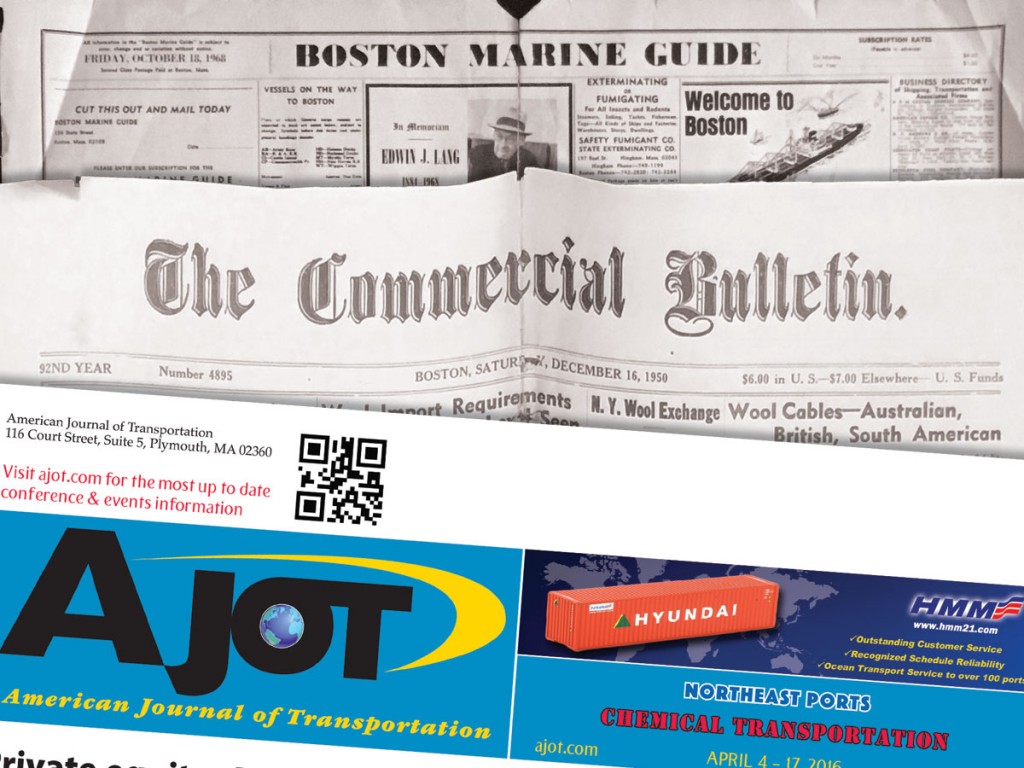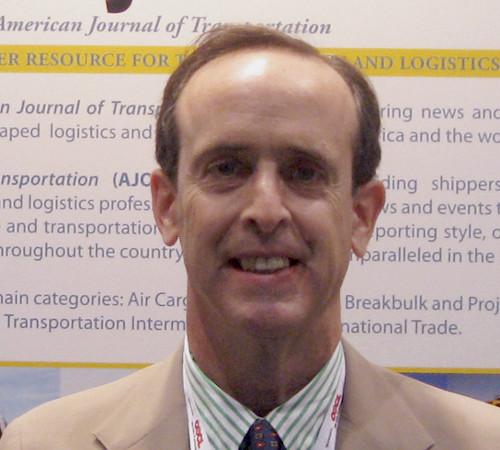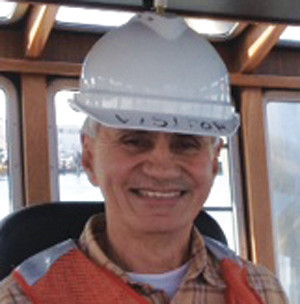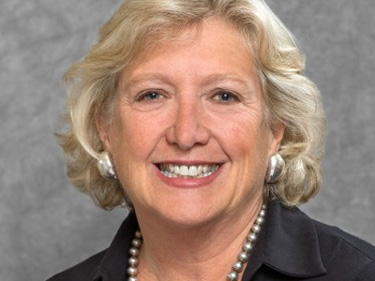It might be said that the first step of the evolution of the Boston Marine Guide becoming the American Journal of Transportation (AJOT) happened in 1981 when the title was changed to Boston Marine Guide and New England Transportation Review. It was already becoming clear that port-specific news was giving way to more expansive coverage. Questions like the Canadian Diversion or 50-Mile Rule weren’t just local issues and needed broader context.
In 1986 Dick Hurley bought out Al McCarty’s interests and moved both the Boston Marine Guide and Commercial Bulletin to South Boston. During this period the first semi-computerized typesetting began, a whiff of the computer revolution just around the corner. In 1989, Robert “Bob” Coyne, owner of Boston Consolidation Services (BCS) - a South Boston-based NVO (Non-Vessel Owning Common Carrier), bought the two papers and moved them into his facilities. Coyne, a well-known local businessman, was a pioneer in the NVO business and not coincidentally a weekly advertiser in the Boston Marine Guide.

Among the new staff hires were William “Bill” Bourbon and Robert “Bob” Kirk. Bill Bourbon, a Mass Maritime graduate, had been to sea and looking for a landside employment took on the task of head of sales. While Kirk, a recent graduate from Emerson College, after a stint in the Air Force was looking to land a job in publishing. Bob Kirk initially took over the Commercial Bulletin but when it ceased publication, he shifted over to production of the Boston Marine Guide. In 1992, in keeping with the new approach, the Boston Marine Guide is renamed the Northeast Journal of Transportation.
In a curious happenstance, on April 1st “April Fool’s Day” 1994, Bill Bourbon and George Lauriat officially bought the Northeast Journal of Transportation from Bob Coyne. With the purchase, Bourbon became Publisher, Lauriat, Editor-in-Chief and Kirk, Managing Editor.
After a brief period, in 1995 the company moved from South Boston to Quincy, MA and for the first time in the publication’s 77-year history, the paper isn’t based in Boston.
At the same time, the paper is again renamed and now is called the Atlantic Journal of Transportation. The name-change was noteworthy as business from other ports on the East Coast and even the Gulf were regularly represented in the pages. This move also coincided with the signing of NAFTA (North American Free Trade Agreement) between Canada, Mexico and the US – an agreement that re-shaped trade in North America.
AJOT Emerges – What’s in a Name?
Even as the Atlantic Journal of Transportation, in 1995 it was already clear that the name wasn’t matching the current content of the paper or the publication’s plans in the near future. But another title change brought its own set of difficulties - starting with finding a new title to reflect both the present and future of the publication. Publisher Bill Bourbon suggested swapping out Atlantic for American and the transition was surprisingly easy.
So, with the first edition in 1996 the new title American Journal of Transportation adorned the masthead. With the first AJOT edition came a number of letters and comments endorsing the new title – and with that there was a mesh of the coverage and appearance.
As AJOT’s goals expanded so did the roles of many of the regular contributors to the AJOT.
In the 1980s, a former freight forwarder Robert “Bob” Stetson had a column called “Industry Profiles” in the paper. The profiles were largely Boston area companies, often importers or exporters. Over the years, Paul Scott Abbott, a Georgia-based correspondent took over the role along with the coverage of industry events all over the country for the AJOT. His reporting on AAPA (American Association of Port Authorities), Southeastern port events and coverage of Gulf ports has widened the AJOT’s reach.
In Canada, Leo Ryan a Montreal-based award winning correspondent, who was based in Paris for 18 years, put the AJOT’s shipping and trade coverage on a par with any publication. Another long time correspondent Peter Buxbaum, a former lawyer, has become the go-to on international trade matters such as tariffs. [Editor’s note: Curiously, after many years of editing his work, this editor finally met Peter in Calgary on a media junket.] And his reporting on steel and steel related commodities in the AJOT’s Breakbulk Quarterly sections has become essential reading to keep up with the sector’s shipping and trade trends.
Over the years, Robert Wallack, a frequent overseas traveler, has reported from various exotic locations like Urumqi and Vietnam on projects and trade. Manik Mehta is another correspondent that has spent countless days on road trips to Europe and Asia. He’s filed stories from Taiwan, India, Germany and other places over the past two decades for the publication.

California based Stas Margaronis is another two decade-plus correspondent for AJOT with an asterisk of doing it in two different stints. Margaronis has a keen nose for what is new and unusual. He’s contributed articles on West Coast ports and filed articles from abroad on subjects like South Korean shipbuilding to Dutch storm surge expertise. Matt Miller, another award-winning journalist, has written some of the most in-depth features the AJOT’s ever published. He began his career in Hong Kong as an investigative financial journalist with the Asian Wall Street Journal, before returning to the U.S. and working at a New York City-based business publication, “The Deal”. Matt’s contributions have moved the AJOT into the “business and financial” reporting space that was missing before his arrival. [Editor’s note: we met in Hong Kong and it was a few decades before we renewed acquaintance at the AJOT.]

People, Places and Associations
The advent of the AJOT didn’t happen in a vacuum. There were many people and groups that had a hand in pumping life into the publication’s coverage. While many of these organizations like the AAPA, NITL (National Industrial Transportation League) or NRF (National Retailers Association) are well known, other trade groups less so but they are no less important in the pursuit of understanding logistics and trade.
There’s an old expression, “everything old is new again,” and in the case of covering Breakbulk shipping that most certainly is true. The Breakbulk quarterly series and the two Project editions have been remarkably successful – almost running counter to the long-standing dominance of containerized shipping.
For the AJOT, a number of individuals and associations have played a heavy role in building the coverage. Wolfgang Karu and the WWPC (Worldwide Project Cargo) group of project freight forwarders were among the first. The WCA, founded by David Yokeum – the godfather of the freight forwarding associations, also was important not only on the project front but in introducing the AJOT to a global community of air and ocean forwarders. The expertise of the organization is unrivaled. Another standout forwarding association is the Advanced International Networks managed by Gary Dale Cearley. Cearley, an amateur linguist and lifetime world traveler, has been a source of insights particularly on Asia that’s hard to match.

Another important group closer to home (Plymouth) is CONECT (Coalition of New England Companies for Trade). CONECT under executive director Carol Turner has become one of the most influential trade groups in the U.S. – a remarkable achievement – and the AJOT was fortunate enough to be there from the beginning. Washington, DC-based Peter Friedmann is the lobbyist for CONECT and provides special insights on politics inside the beltway. He also represents the Agriculture Transportation Coalition (AgTC) which brings another crucial element of US trade to the table.

Another industry trade group that’s been influential in shaping AJOT coverage is the SMC3. The SMC3 group, an Atlanta-based trucking organization, and their annual conferences have provided a unique platform that’s helped explain the business of the US trucking industry by regularly putting together top notch presentations.
The AJOT has participated in many sponsorships both in North America and abroad. Sponsorships like Singapore Maritime Week or the Hong Kong’s Asian Logistics Maritime conference have widened the publication’s reach and broadened the company’s contacts… as well as countless air miles, taxi rides, hotel reservations and new and exotic cuisine in the process.
Of course, the process has dramatically changed over the past thirty years with the computers, cell phones, the internet, rise of social media and news cycle running 24/7. But embracing the new doesn’t mean discarding everything tried and true – remaining capable and professional is essential to delivering information regardless of the medium.
So, as the AJOT moves into another century of business, it’s interesting to at once both look back to what has come before (Edwin Lang’s world) and then try to imagine what may lie just over the horizon: a world bursting with new technologies and ideas waiting to be unveiled.
As F. Scott Fitzgerald wrote in the last line of The Great Gatsby, “So we beat on, boats against the current borne back ceaselessly into the past. Sometimes, in the past, we rediscover ourselves and new paths to our futures.”






